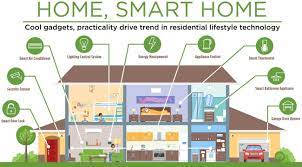What Is A Smart Home? How To Experience An Imaginary Life In Reality
The idea of the smart home began in the fantasy world, became a reality in the 1960s, and is becoming more and more amazing with the advancement of technology.
Follow this article to know more about smart homes.
It may have occurred to you that when you go out or travel for a while, you become worried about what might happen at home that you are unaware of. Doubts like I turned off the gas? Did I activate the alarm? Children at home are doing homework or watching TV do? They may take away from you the comfort you wanted to get on the trip.
The smart home puts an end to all these worries with a glance at your smartphone or tablet. Appliances and appliances can be connected so that they can communicate with each other and with you, even if you are hundreds of kilometers away from home.
Any device that uses electricity can be connected to the home network and under your control. Whether the command is voice, remote control, or pressing buttons in a phone or tablet app, the home responds. Most devices that connect to a smart home network are related to lighting, security, entertainment, and room temperature regulation.
The phrase “smart home” may remind you of a very old movie of the same name ( Smart House ) in which members of a family of three win house-to-house competitions run by a virtual assistant called PAT (Personal Applied Technology). . Or maybe imagine Theodore Toumbley’s house in Her, where the lighting system is automatic and has a motion sensor. A house where Theodore falls in love with his computer operating system and can easily talk to a virtual reality game character who moves in the form of a hologram in his house.
There are more than 175 million smart homes in the world
But the concept of the smart home has long been out of the realm of imagination. Leaving aside the smart home of billionaires like Bill Gates, who spent nearly $ 100 million to build it, the effects of this amazing technology can be seen in many homes around the world. There are currently more than 175 million smart homes in the world, and the annual compound growth rate for the market is projected to grow by 25 percent from 2020 to 2025.
The concept that once existed only in science fiction has now become fashionable, and instead of startups, high-tech companies like Amazon and Google have taken over the industry and taken control of it.
The reason for the pandemic of smart homes is the significant progress that has been made in smartphones and tablets. These lightweights, portable computers can be found everywhere, and their constant connection to the Internet means they can control many electronic devices.
It all started with the imagination and culminated with the Internet of Things (IoT). In the IoT context, many products are interconnected, and this collection is getting bigger and better every day. All the electronic devices in the home can serve this technological revolution and change human life in such a way that it is in no way comparable to a few decades ago.
If you want to know more about the smart home, its key components, the advantages and disadvantages, and the future of this technology, join this article.
What is a smart home?
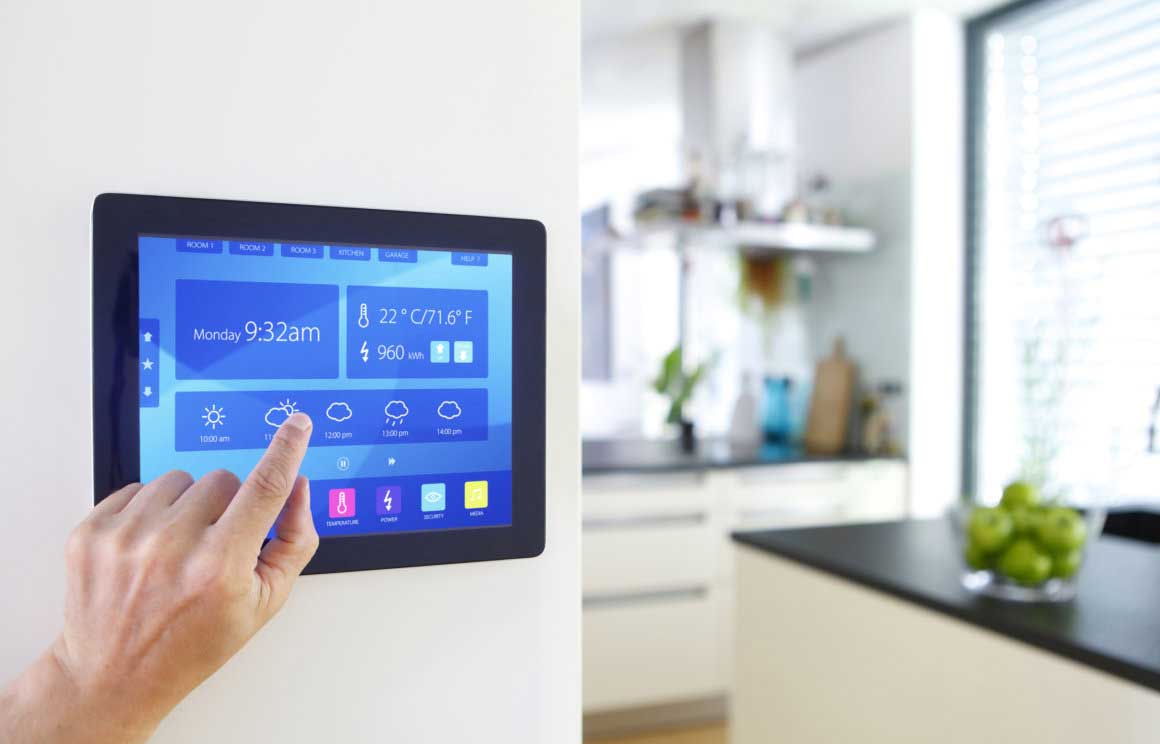
Imagine for a second you were transposed into the karmic-driven world of Earl. Not just computers and cell phones, but everything; From wall clocks to speakers, lights, doorbells, cameras, windows, shutters, water heaters, kitchen appliances, and anything else you can think of.
Now imagine that all these devices could communicate with each other, send information to each other and fulfill your requests with just a voice command or the touch of a button in a mobile app. This is not a science fiction story, but the Internet of Things (IoT) and is a key part of smart home automation.
Home smartening started with ECHO IV
Home automation is exactly what its name implies: automating the ability to control home appliances with the push of a button or voice command. The term “smart home” is also used to describe a home in which all automated activities related to lighting, appliances, heating, television, air conditioning, audio, video and entertainment systems, computers, cameras, and security systems are interconnected. و They can be controlled from one place, whether from inside a room in the house or from a place far away from home. Basically, it can be said that a smart home means the ability of electronic devices to communicate with each other, or in other words, the ability to “talk” to each other.
Smart Home History
Some people associate the beginning of a smart home with a product called ECHO IV, which was produced in the 1960s. This home computer can be used to do a few small things, such as adjusting the room temperature or turning on certain electrical appliances in the house. This product never hit the market, But it was a step forward in the path of a smart home.
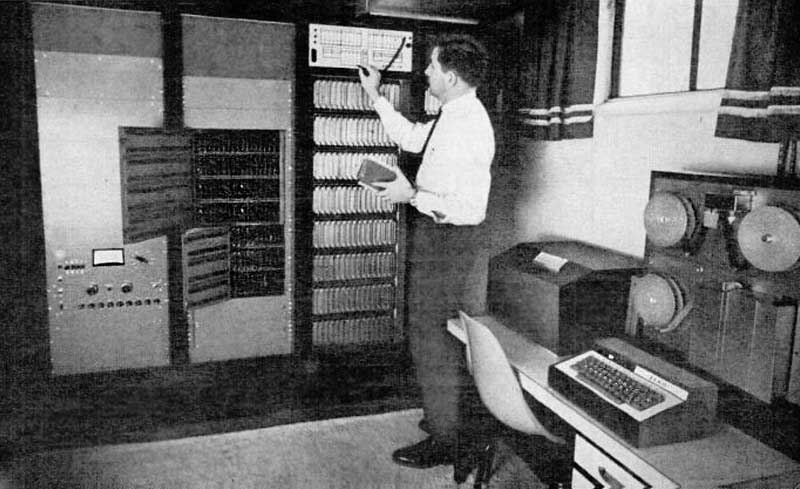
ECHO IV was the first home automation system to be used for simple tasks such as storing shopping lists or adjusting room temperature.
Leaping to 1975, we come to the X10 system, which added more excitement to the smart home story. The X10 was a system that, through power lines, could connect multiple home appliances, turn lights and appliances on or off, or raise shutters.
However, this system was not completely flawless. Because the connection required pre-existing lines instead of dedicated wiring, the signals could not always pass through these lines. Products may read the signal from elsewhere and interfere with their operation; But despite this big problem and other problems such as slowness of speed and limited capabilities, the X10 was a breakthrough in technology; So much so that today, despite better options, different products still use the X10.
Over the years, automation became more popular, and independent connections (whether wired or wireless) prevented signal congestion and interference. Today, some electronic products are so easily connected to an intelligent system that you can do it yourself on your own with just a Wi-Fi network.
What is an intelligent system?
The intelligent system is actually the command center or the mastermind of the house that controls all the devices. In general, an intelligent system is what you talk about when you want something to be done automatically; But the smart device is the product that reports to the system; Like Amazon Echo or Philips Hugh lamps.
Now let’s take a look at 4 of the best smart systems of 2021:
1- Alexa Amazon
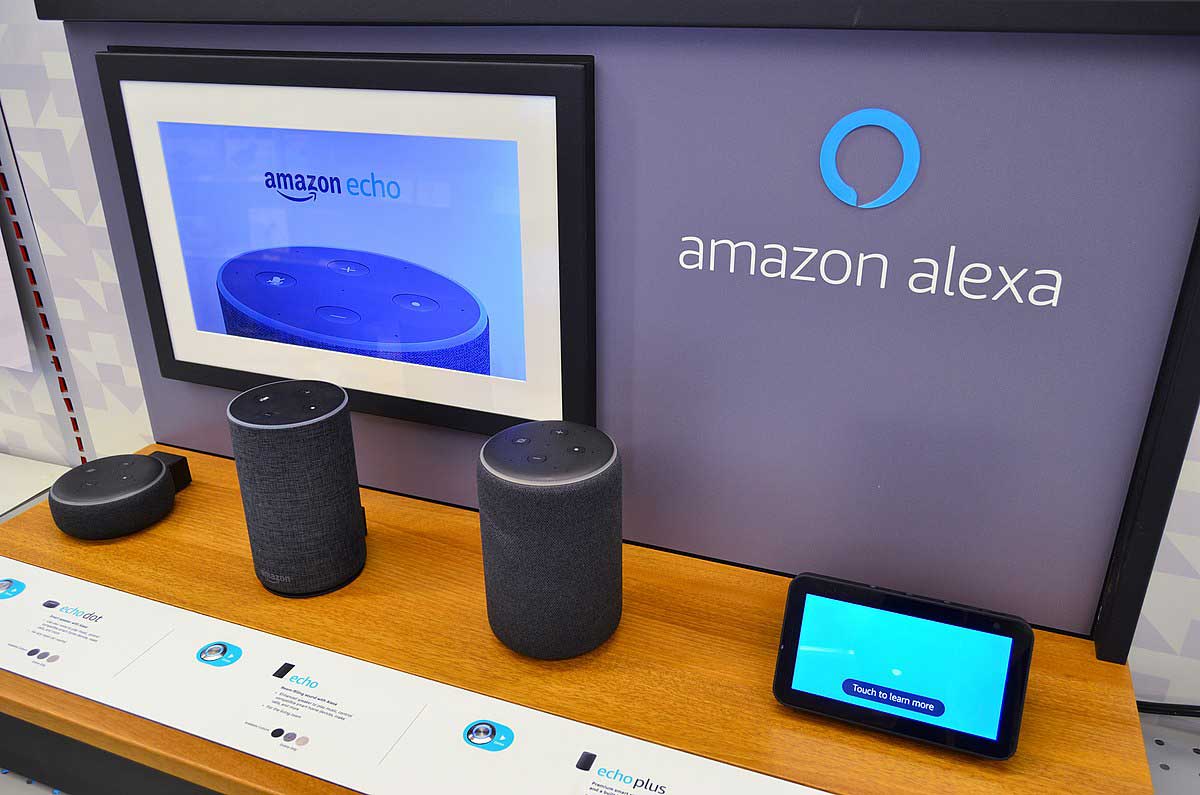
With hundreds of millions of compatible devices, Alexa is without a doubt one of the most comprehensive smart home ecosystems on the market. You’ve probably heard the name Alexa many times when using Echo smart speakers ( Alexa, how is the weather today? Alexa, play a song. ) But you may not know that Alexa is now included in many other smart products, including thermostats and televisions. And is ready to do your voice commands.
Alexa makes it easy to access all aspects of the smart home. You can easily ask Alexa to play a specific song on Spotify or turn off the lights. Because the Amazon ecosystem is one of the most popular in the industry, most smart products, including those from Philips, Samsung, Nest, and Schlage, are compatible with Alexa. Alexa can now lock you in the parking lot, lock the doors of the house and adjust the temperature of the rooms to your liking. Interestingly, Amazon’s Large largest share (69. 7% compared to 31. 1% of Google) in the market of smart devices and will keep this position until 2021.
2- Google Voice Assistant (Google Assistant)
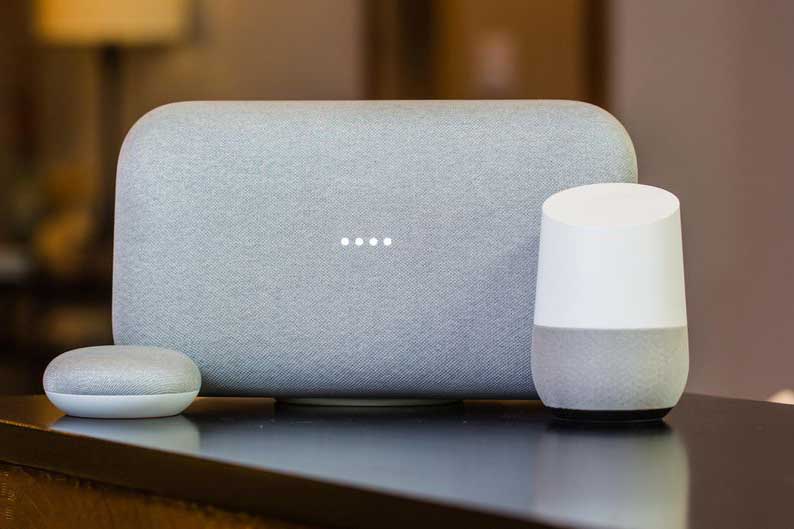
After Alexa, Google Assistant is the most popular smart system in the world, which is not as compatible with various devices as Alexa; But thanks to Google’s search engine, it can often answer complete questions and requests that are beyond Alexa’s control.
According to ZDNet, the accuracy of Google Voice Assistant is 92.9%, while for Alexa it is 79.8%. Google Assistant also has a better understanding of the natural way users talk. For example, if you tell a Google Assistant “I do not like this song”, the next song will be played on Spotify, while Alexa will tell you, “Up and down thumbnails are not supported on Spotify.” Small differences like this can lead the user to choose Google because it understands requests better than Alexa.
The assistant is also compatible with products from major brands such as Philips, Belkin, August, Nest, and popular apps such as Spotify and Uber.
3- Wink Hub
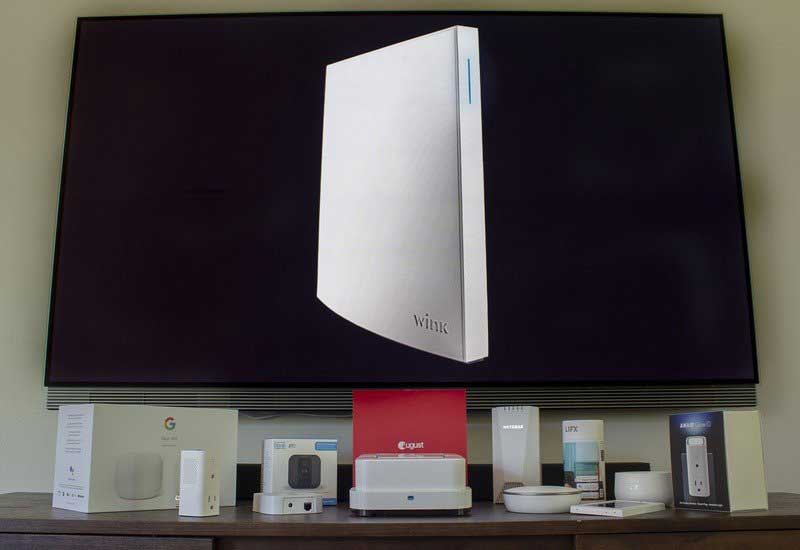
Wink Hub introduces itself as “the first smart home hub designed for the general consumer.” Unlike Alexa or Assistant, Wink does not have brand loyalty and allows the user to integrate any product of their choice with the smart system seamlessly.
WinkHub 2 supports smart home protocols including Bluetooth (BLE), Kidde fire alarm systems, Lutron intelligent lighting system, WiFi, Z-Wave protocol, and many more. This system is the best choice for an integrated smart kitchen and all appliances.
4 – Samsung SmartThings Hub (Samsung SmartThings Hub)
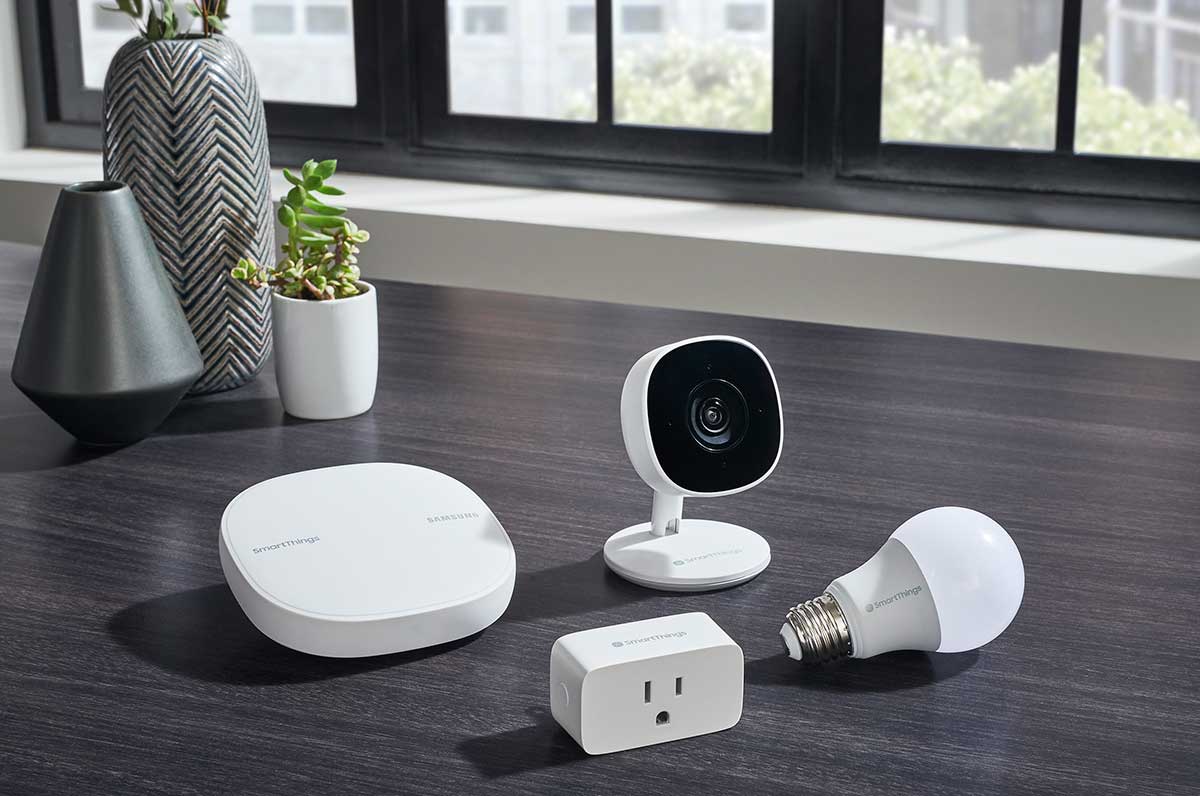
This Samsung system connects a wide range of smart devices from different brands, including thermostats, temperature routers, Wi-Fi routers, light bulbs, and security devices.
The SmartTings system has been increasing the number of smart devices that can be connected to its ecosystem over the past few years. The product range of this hub includes smart power sockets, lamps, and dedicated cameras of this brand. With SmartTings, you can also set up compatible smart devices to perform a variety of activities, including turning lights on / off as you walk into a room. Samsung Smart System has its own hub, but you can also integrate it with Alexa or Assistant.
Smart home components
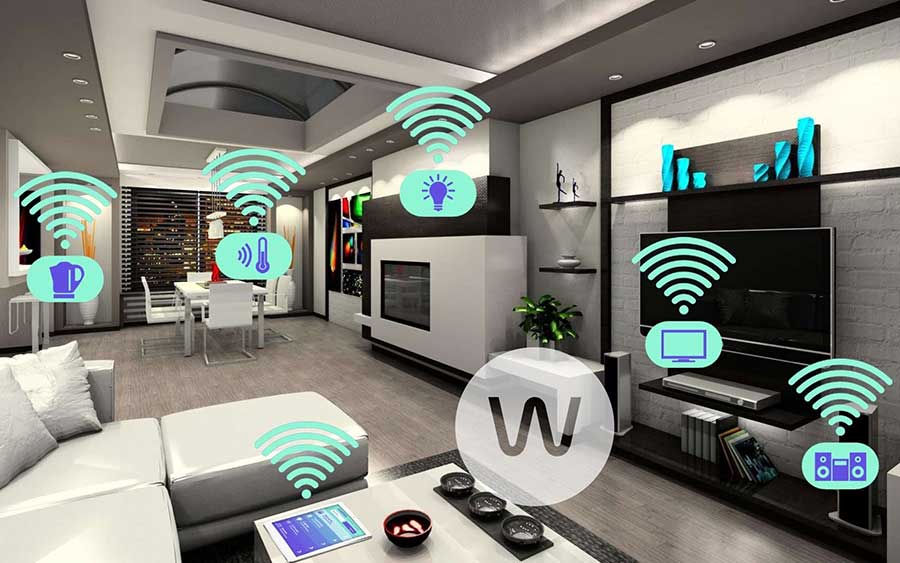
You may be wondering what to buy to have a smart home and what products make the home smart. In practice, almost any electronic device can join the smart home system; But the important question is not what device can, but what device should be connected to the smart system. Likewise, it is not the device itself that matters, but how it is used. People with immense wealth can go to extremes. For example, Microsoft co-founder Bill Gates has smartened his entire home down to the microchip that guests pin into their chests to store personal data about their brightness, music type, and preferred temperature.
But for ordinary people with a more reasonable income, such a degree of intelligence is a bit far-fetched and, of course, beyond their budget. The components mentioned below are present in most smart homes.
Control system and network
Every smart home needs, first and foremost, a control system that, as the “whole-brain” of the home, receives information through installed sensors. Alexa and Google Assistant are two of the most popular smart systems.
The sensors, after being set up and located in different parts of the house, transmit the internal and external conditions of the house to the control system to execute commands related to lighting, temperature, ventilation, and turning on or off connected devices. Most control panels are equipped with software that “learns” when used; But if necessary, their agenda can be entered manually.
The control system usually determines the brand of products that are to be connected to the smart grid and interact with the system and each other; That is why choosing this system for a smart home is a priority.
Room temperature control
To control the room temperature, a wireless receiver and thermostat are installed to connect the building heating/cooling system to the control system. Then, with the help of applications installed on tablets or smartphones, or other remote control devices, the desired temperature can be set based on the hours of the day or days of the week. Some of these systems can even adapt to the user’s behavior and learn and apply the desired temperature without any input data.
Some temperature control systems can be controlled by sound. These devices can even detect your location in the house and change the room temperature according to your presence.
Security
One of the key components of a smart home is its wireless security system. The system includes motion detectors to turn off the lights, lock the doors with locks alert bad guys or electronic.
This system is configured to send a warning message to the user’s phone or tablet in case of danger of theft or fire and other accidents. Sensors connected to parking lots, firefighting, and security systems immediately alert the user in the event of a problem.
CCTV cameras are also part of this security system. Some of these models, including the Arlo and Maximus rim cameras, have headlights that illuminate the road. Interlocking cameras can monitor movements and allow the user to interact with guests without approaching the door or even without being at home.
Lighting and home appliances
For many people, the smart lighting system is the most attractive feature for a smart home. In the smart home, you can easily turn the lights of the room or appliances on and off, or turn the lights on and off by simply pressing a button on the app.
Of course, many lighting systems can work well without the need for a central hub and interact with other components. For example, lamps made by Cree or TP-Link can work via Wi-Fi, and others, such as Philips Hugh lamps, can work via Bluetooth on a smartphone without the need for a control system.
WATERING systems
Water is the most valuable natural resource, and therefore having an intelligent irrigation system, in addition to user comfort, prevents water wastage. Smart sensors irrigate your backyard or garden plants without wasting water and stop watering when it rains. One of the advantages of this advanced technology is that there is no need to connect to a central hub.
Entertainment
With the right equipment, TV signals can be transmitted wirelessly throughout the house. That way, you can enjoy TV shows or video games in all the rooms connected to the central hub, with just one player in the house. Audio systems also support this feature.
IFTTT application
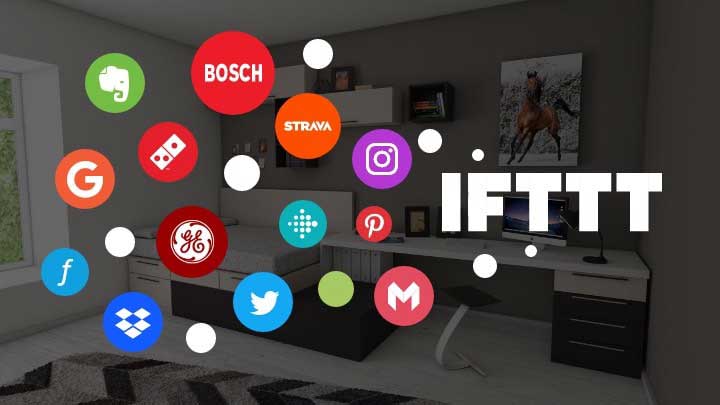
One of the most powerful ways to integrate devices into a smart home is to use the IFTTT app. The name of this application stands for “If This Then That” and it is a service in which activity on one device leads to another activity on a different device.
IFTTT is very similar to having a home hub in the cloud and supports many products and services. This app was once free, But now the free account only allows each user to create three commands (called applets). Of course, you can use thousands of applets created by other users and available in this application without any restrictions.
An applet command, for example, could be that the Philips Hugh smart bulbs start flashing every time the time set for Amazon Echo expires. If the app you need is not available in this app, you should buy a Pro account, which costs $ 3.99 per month.
The best smart homes in the world
Chicago Museum of Science and Technology
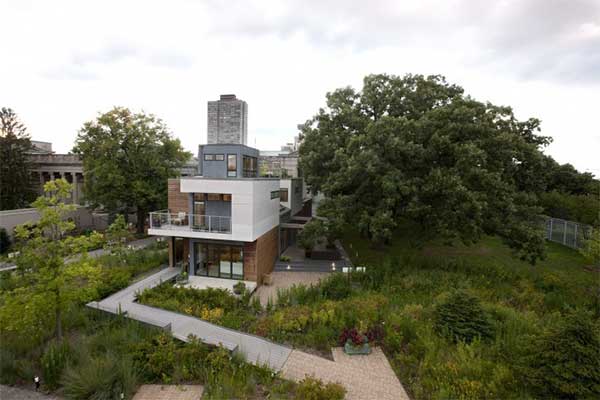
This three-story house, designed as a museum for two people, is one of the best smart homes in the world with the help of two smart and green technologies, including an automation system that controls the amount of energy consumption of the house. Looking in the bathroom mirror of this building shows not only the reflection of your face but also the news and the weather. You can set a time limit for taking a shower to alert you when it exceeds this limit.
The skylights and shutters in this building are remotely adjustable, and the security and entertainment systems are controlled by the most advanced touch panels.
The kitchen counter may seem ordinary at first glance; But by placing electronic devices on its surface, it charges them. This smart home also has a robotic lawnmower.
Wired Smart Home

The house that LivingHomes built for Wired Technology Magazine in Los Angeles, though not very smart with its modular design; But inside it is a completely different story.
In this home, a central media server from all connected handsets sends updates to monitors installed throughout the home. In addition, a central automation system controls all lighting, heating, ventilation, entertainment, and security systems, and is also used as an intercom system.
Bill Gates Smart Home: Xanadu 2.0
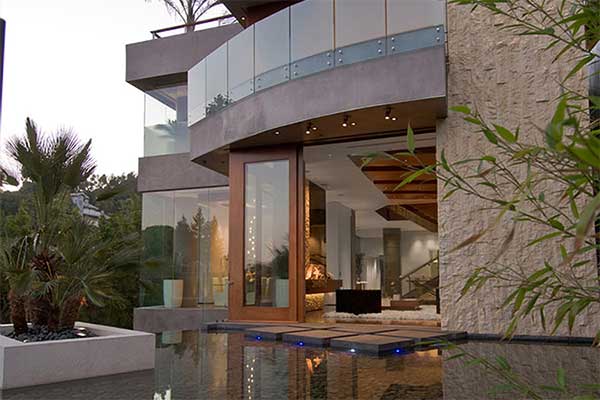
As expected, Bill Gates’ home in Washington is equipped with state-of-the-art technology. The $ 130 million houses, known as Xanadu 2.0, took seven years to build.
Each occupant of the house has a microchip pinned to the chest that is monitored throughout the house by sensors. With the help of these microchips, the temperature and brightness of the room are adjusted according to the people entering each room and according to their preferences. Music “follows” residents throughout the house, and large screens display paintings, drawings, and favorite images at the touch of a button. Even guest rooms have all these smart features.
Bill Gates’ favorite tree is also connected to the computer and is automatically watered as soon as the humidity drops.
Intel Small House
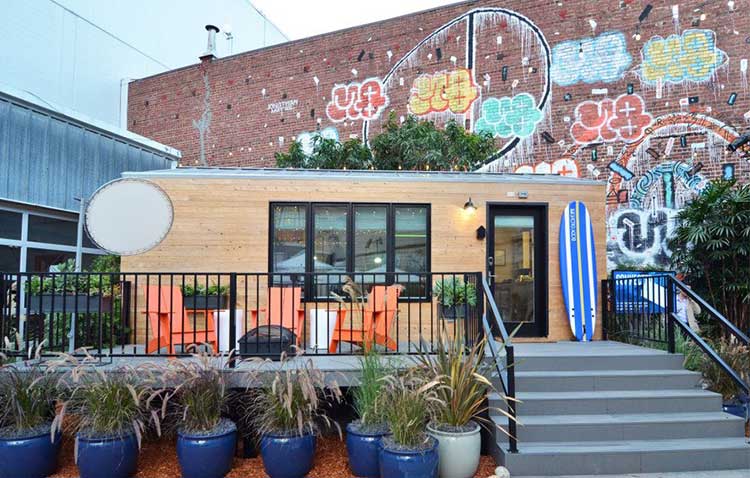
A company that is fascinated by making technology products as small as possible should also be expected to build a small smart home. This 20-meter house is full of smart devices. With the help of an application on the tablet, you can adjust the brightness of the house, lock the door, activate the keyless entry with face recognition, and change the room temperature.
The entrance system to the Intel smart home can be remotely controlled so that the landlord, even if in another city, can see the person behind the door and let them into the house if they wish. Best of all, you do not even have to get up in this small house. Voice recognition software allows you to easily control everything with voice commands.
The benefits of a smart home
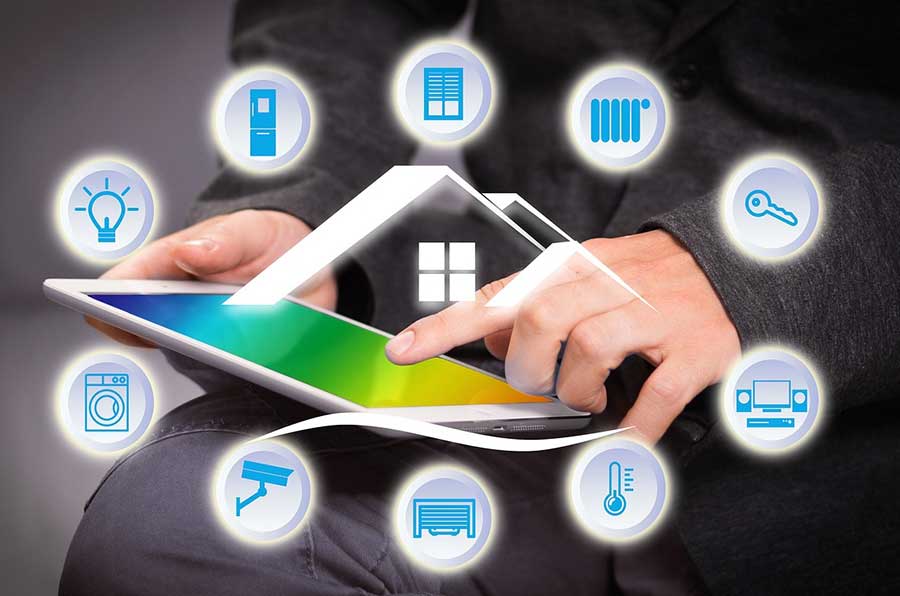
Comfort and convenience
In today’s fast-paced society, the less you worry, the easier your life will be. Managing all your home appliances from one place and getting rid of small hassles such as turning off the lights before going to bed or adjusting the room temperature when you wake up is one of the main reasons people turn to a smart home.
Many intelligent systems have remote control capabilities; That way, if you forget to turn off the coffee maker before leaving the house, you do not have to go home again. All you have to do is access the remote control system on your phone or computer to turn off the device in a few seconds.
Security
As mentioned, smart homes include advanced security systems that provide greater security for homeowners through CCTV, motion sensors, and connection to a local police station or private security company. In smart homes, a card key or fingerprint can be used instead of regular locks to make it more difficult for thieves to enter the house.
Optimal energy consumption
Smart homes use less energy. Room temperature and lighting can be adjusted according to user consumption. Intelligent heating and cooling systems can save up to 50% in energy consumption.
For example, when no one is in the room, the lights can be turned off automatically and the thermostat can be adjusted so that the indoor temperature drops during the day and returns to normal just before the occupants arrive. All of this automation, along with modern, low-power devices, save electricity, water, and gas.
Availability
Smart homes can provide more comfort and convenience for the elderly and people with disabilities through accessibility features such as voice command systems for locking exit doors, adjusting room brightness, or even working with a computer.
Increase the value of the house
Homes with smart capabilities can be sold at a much higher price than regular homes. According to the American Real Estate Association, buyers are willing to pay more for homes with features such as smart security, temperature control, home appliances, and entertainment.
Disadvantages of smart home

Security and privacy
Although smart homes offer modern security methods; But at the same time, they can create security concerns for themselves. According to a 2019 report by Avast, of all the smart homes in the world, 40.8% had at least one vulnerable device to cyber-attacks connected to the control system, which endangered the security of the entire home. It is interesting to know that printers are the most vulnerable device in the home in terms of security.
According to McAfee, in 2016, a virus-infected more than 2.5 million IoT devices in homes and offices around the world. Of course, many of these vulnerabilities were blamed on the use of simple default passwords for these devices; Passwords such as passwords or 666666 or Dreambox that can be easily hacked.
On the other hand, smart speaker systems also have their own security holes. Their voice recognition system can be deceived. Other devices (even TVs and radios) may interfere with their operation. Hackers can also gain control of the speaker settings by hacking into the WiFi network.
There are also privacy concerns about the Internet of Things. Manufacturers of digital thermostats, smart bulbs, and even alarms store large amounts of user information, and hackers’ access to this information can be troublesome.
Weak WiFi signal
Standard modems are not very suitable for intelligent systems and disrupt the performance of many connected devices. Lights are adjusted slowly, CCTV videos are delayed, and smart lock notifications are sent an hour later.
Using a mesh network (WiFi mesh) that distributes wireless signals from multiple locations more efficiently with multiple routers can solve the problem of poor signal. The network can also be modified to send stronger signals to devices that need more bandwidth.
Cost
It is true that the launch of an intelligent system dramatically increases the value of the home; But for many people, buying this system is not possible in the first place due to its high cost. According to Fixr, to have a smart home, on average, costs between $ 2,000 and $ 7, and this figure for homes with lighting, shutters, locks, appliances, irrigation system, thermostat, central hub, and smart speakers in all rooms It can reach up to $ 20,000.
The future of smart home
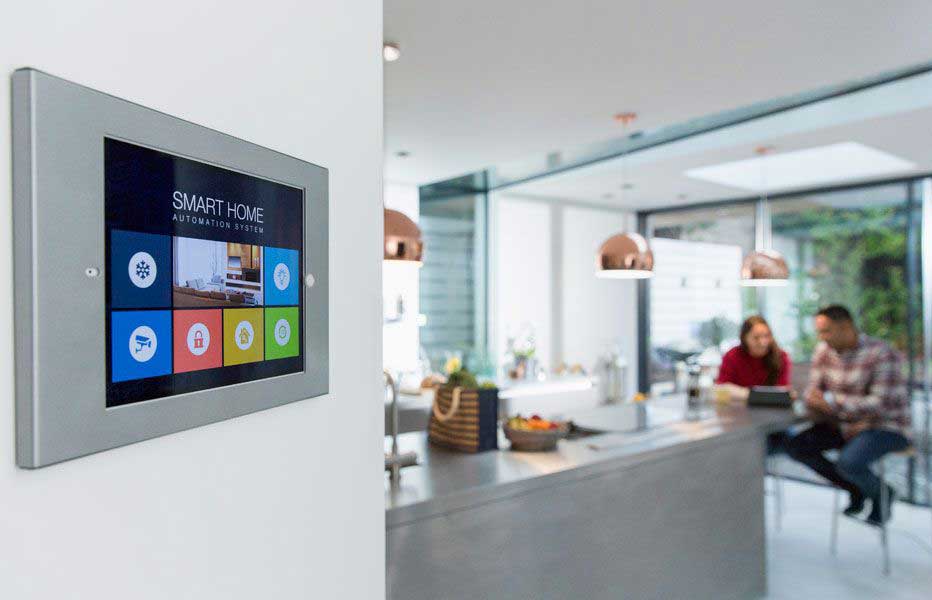
The idea of a smart home may seem commonplace now; But until a few decades ago, it was only present in the valley of human imagination. Years before the advent of Alexa, Siri, Cortana, or Google Assistant, the idea of home AI with a virtual assistant called PAT was introduced in Disney’s 1999 movie “Smart Home,” which manages the home with resident voice commands and all habits. He had preserved their interests.
Tablet in 2001: The Kubrick Space Odyssey was a science fiction gadget. The Return to the Future trilogy also envisioned a type of smart glasses that resembles today’s Aquil Rift virtual reality headset. The idea for smartwatches began with the pioneers of space.
It’s been 22 years since the movie “Smart Home” was made, and technologies such as smart lighting, smart temperature control, smart locks, and robotic vacuum cleaners are so common that no one is surprised to see them again.
TV screens cover the entire wall, smartphone-like artificial intelligence is in many people’s pockets, and Internet-connected devices set alarm clocks, send messages, make calls, and play music instead.
Health sensors monitor our health, and virtual and augmented reality have connected the world of imagination to our real life.
However, there is a long way to go before a system like PAT can be integrated; But Alexa and Google Assistant now have a strong foothold in the smart home market, and as a powerful virtual hub, they take control of multiple devices from a single point.
In the future of the smart home, we can expect better connectivity between smart devices. Personal connection hubs such as zig- B, Z-Wave, Wi-Fi, and Bluetooth will soon dominate the smart home market.
The eyes will become accustomed to seeing more robotic devices that, as humans advance in artificial intelligence, along with cooking and cleaning, can be good companions and assistants for the elderly and infirm.
The smart home will eventually reach its highest level of perception
The smart home will eventually reach the highest level of perception and will manage all the needs of the residents of the house in a completely intuitive and instinctive environment.
This home model automatically adjusts to real-time, AI-based devices synchronize with the intelligent system as efficiently as possible, and data is collected together so that machine learning can optimize all processes in the best possible way. Slowly
In a few years, smart homemakers will focus on collecting the least amount of data to provide the most service to users. Smart devices are becoming smarter. The presence of artificial intelligence technology and machine learning is becoming more prominent.
The fifth-generation mobile network (5G) will undoubtedly revolutionize IoT services by increasing data transfer speeds up to 20 Gbps.
By 2025, 5G technology is reported to have nearly 2.6 billion users, bringing the annual value of the global IoT market to $ 3.9-1.1 trillion.
